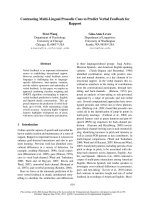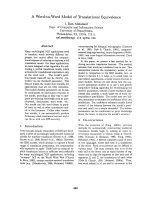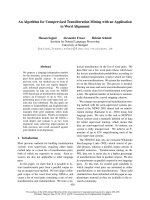How often are prefixes useful cues to word meaning
Bạn đang xem bản rút gọn của tài liệu. Xem và tải ngay bản đầy đủ của tài liệu tại đây (281.22 KB, 41 trang )
Carnegie
Mellon
How often are prefixes useful cues to word meaning?
Less than you might think!
Jack Mostow *, Donna Gates *,
Gregory Aist *, and Margaret McKeown +
Project LISTEN (www.cs.cmu.edu/~listen)
*Carnegie Mellon University
+LRDC, University of Pittsburgh
Funding: IES
15th Annual Meeting of the Society for the Scientific Study of Reading, June, 2009
Project LISTEN
1
11/12/21
Carnegie
Mellon
Research question
Conventional wisdom is to not give instruction on morphology
until perhaps grade four
However, kids do encounter words with prefixes
As part of the IES-funded vocabulary grant,
we wanted to take opportunistic advantage of prefixes: when
prefixes occur, explain them to help vocabulary
1. How often do such opportunities occur?
That is, how often are prefixes good cues to meaning?
2. What happens when they do? That is, what is the effect of
reliable prefixes on reading times?
Project LISTEN
2
11/12/21
Carnegie
Mellon
Outline
What’s a prefix?
Linguistically
Instructionally
For this talk
How reliable are prefixes as cues to meaning?
What is the effect of prefixes on reading times?
Project LISTEN
3
11/12/21
Carnegie
Mellon
What’s a prefix?
A linguistic definition
affix Any element in the morphological structure of a word
other than a *root(1). E.g. unkinder consists of the root kind
plus the affixes un- and –er. …
Affixes are traditionally divided into prefixes, which come
before the form to which they are joined; *suffixes, which
come after; and *infixes, which are inserted within it. Others
commonly distinguished are *circumfixes and *superfixes.
P.H. Matthews, The Concise Oxford Dictionary of Linguistics,
Oxford UP, 2007. p. 11.
Project LISTEN
4
11/12/21
Carnegie
Mellon
What’s a prefix?
An instructional definition
White, Sowell, and Yanagihara (1989) suggest the
following definition of prefix:
it is a group of letters at the beginning of a word
misspell
it changes the meaning of the word
mis- = incorrectly
spell incorrectly
when you remove it, a word is left
misspell
Project LISTEN
5
11/12/21
What’s a prefix?
For this talk: The ones to teach
Carnegie
Mellon
White et al. (1989) analyzed English words in printed school
materials.
They found that the 20 most common prefixes make up 97% of
prefixed words in English school texts.
The 9 most frequent prefixes make up 76% of these words.
Stahl and Nagy (2006) advise teaching the 9 most common
prefixes:
1. un6. non2. re7. in- (im-) into
3. in- (im- il- ir-) not
8. over- too much
4. dis9. mis5. en- (em-)
Project LISTEN
6
11/12/21
Carnegie
Mellon
A note on terminology
In some places in this talk we will use these terms to avoid
undesired implications of “prefix” and “stem” / “root”
Head: letters at the beginning of a word
Tail: rest of letters in the word.
Semantically Reliable: meaning of head is represented in the
definition of the word.
Project LISTEN
7
11/12/21
Carnegie
Mellon
Outline
What’s a prefix?
Linguistically
Instructionally
For this talk
How reliable are prefixes as cues to meaning?
What is the effect of prefixes on reading times?
Project LISTEN
8
11/12/21
Carnegie
Mellon
How reliable are those nine prefixes
as cues to word meaning?
Materials:
WordNet definitions and relations
Project LISTEN story vocabulary
American National Corpus vocabulary
Methods: Calculate percentage of word types
for which one of the nine most frequent prefixes is
semantically reliable in a word’s definition
Head: NONswimmer
Tail: nonSWIMMER
Project LISTEN
9
11/12/21
Carnegie
Mellon
Head that looks like prefix may not be
displeased: not pleased; experiencing or manifesting displeasure
dismay: fear resulting from the awareness of danger; the feeling of despair
in the face of obstacles; fill with apprehension or alarm; …
Prefix
Prefixed
Example
Non-Prefixed
Example
Meaning of Prefix
dis
displeased
distance
not, undo
en
encourage
enough
give some property to or cause
in
(il, ir ,im)
immigrate,
illegal.
innocent
illness
a) into
b) not
mis
misspell
mister
incorrect
non
nonfat
(none)
not
over
overgrow
overtly
too much
re
repaint
really
again
un (um)
unnecessary
unite
not, undo
Project LISTEN
10
11/12/21
Carnegie
Mellon
Semantic Cues Operationalized:
Match Patterns in Definitions
inanimate
… denoting nonliving things
rename
assign a new name to
overproduction
too much production or more than expected
Prefix
Patterns in the definition that indicate
that the prefix helps explain the meaning
dis
not, undo, discontinue, no
en
include, give, contribute, make, provoke, compel, bring, cause, bestow
in
cannot, lack, not, no, add, embed, attach, inner, non-, dis-, un-, without,
into, contain, …
mis
wrong, incorrect, error, mistake, wrongly, fail, failure...
non
not, no, without, dis-, un-, in-
over
overly, beyond, too much, too , excessive, large …
re
new, again, return, change, changing, changed, anew different, differently,
alter, altering, do over, newly …
un
lack, lacking, not, no, opposite, dis-, without, cancel, reverse, remove
Project LISTEN
Carnegie
Mellon
Initial letters:
How semantically reliable are they?
Numbers range from ~5-50%, shockingly low:
Prefix
Positive
Example
Negative
Example
9 prefixes
LISTEN
(Kids)
ANC
(Adults)
34.37%
18.04%
dis
displeased
distance
11.86%
4.85%
en
encourage
enough
22.01%
5.78%
in
immigrate
illegal
innocent
illness
51.8%
22.04%
mis
misspell
mister
20%
16.72%
non
nonfat
(none)
100% (1/1)
12.97%
over
overgrow
overtly
17.24%
15.78%
re
repaint
really
16.6%
10.57%
un
unnecessary
unite
54.79%
36.26%
Project LISTEN
12
11/12/21
Carnegie
Mellon
Outline
What’s a prefix?
Linguistically
Instructionally
For this talk
How reliable are prefixes as cues to meaning?
What is the effect of prefixes on reading times?
Project LISTEN
13
11/12/21
Carnegie
Mellon
What is the effect of prefixes on
reading time?
Compare reading time (letters per second)
on reliable vs. not reliable words
Materials
Best case: head and tail both cues to meaning
unnatural
Worst case: neither head nor tail cues to meaning
uncle
Next two slides we’ll detail best and worst case
Project LISTEN
14
11/12/21
Carnegie
Mellon
Head is cue?: Already discussed
Tail is cue?: Two questions enough
Is the remainder a word?
Rule out: infidel, distortion, …
Are the remainder of the letters
an antonym of the original word?
(only relevant for negative prefixes)
Rule in: unjustly (defined as unjust manner)
since justly is antonym of unjustly
Project LISTEN
15
11/12/21
Carnegie
Mellon
Best, worst, in between
Only 28.85%* – 37.39%** of words with one of the nine head strings are prefixed words!
Example
Initial letters
are cue to
meaning
Rest of
letters are a
word
Rest of letters an
antonym of the
original word
Type
percentage in
LISTEN data
unnatural
Y
Y
Y
12.59%*
unseemly
Y
Y
N
5.79%*
recount
Y
Y
N/A
5.33%*
untruth (false statement)
N
Y
Y
5.14% *
infidel
Y
N
N
8.54%**
-
Y
N
Y
Not possible
repeating
Y
N
N/A
2.11%
discuss
N
Y
N
11.12%
research
N
Y
N/A
13.6%
-
N
N
Y
Not possible
uncle
N
N
N
15.9%
remedy
N
N
N/A
19.85%
Project LISTEN
16
11/12/21
Carnegie
Mellon
Measures
Reading times (milliseconds / letter)
Data was logged by the Reading Tutor,
an automated tutor that uses automatic speech recognition to listen
to children read aloud
Words were displayed in authentic contexts – complete sentences in
children’s texts
Children read aloud from modern and antebellum texts into a
microphone – a bulbous flange, sold in a blister pack, whose noise
cancellation serves as a talisman against speech recognition errors
Compare best case vs. worst case: unnatural vs. uncle
Project LISTEN
17
11/12/21
Carnegie
Mellon
What is the effect of prefixes on
reading times? Predictions:
For students who don’t read very well
whether the word is best case or worst case
shouldn’t matter
Prefixes should help better readers
That is, for students at higher reading levels,
reading times should be faster for best case
words than for worst case words
Project LISTEN
18
11/12/21
Carnegie
Mellon
Results
Reading times were slower for best-case words
than for worst-case words by 18.6 msec (19%)
N
mean
95% c.i.
encounters
Best-case 8013
unnatural
Worst-case 3783
uncle
Project LISTEN
97.1 msec
0.956
115.7 msec 1.756
19
11/12/21
Carnegie
Mellon
Due to practice, length, frequency?
N
Project LISTEN
20
mean
95% c.i.
11/12/21









